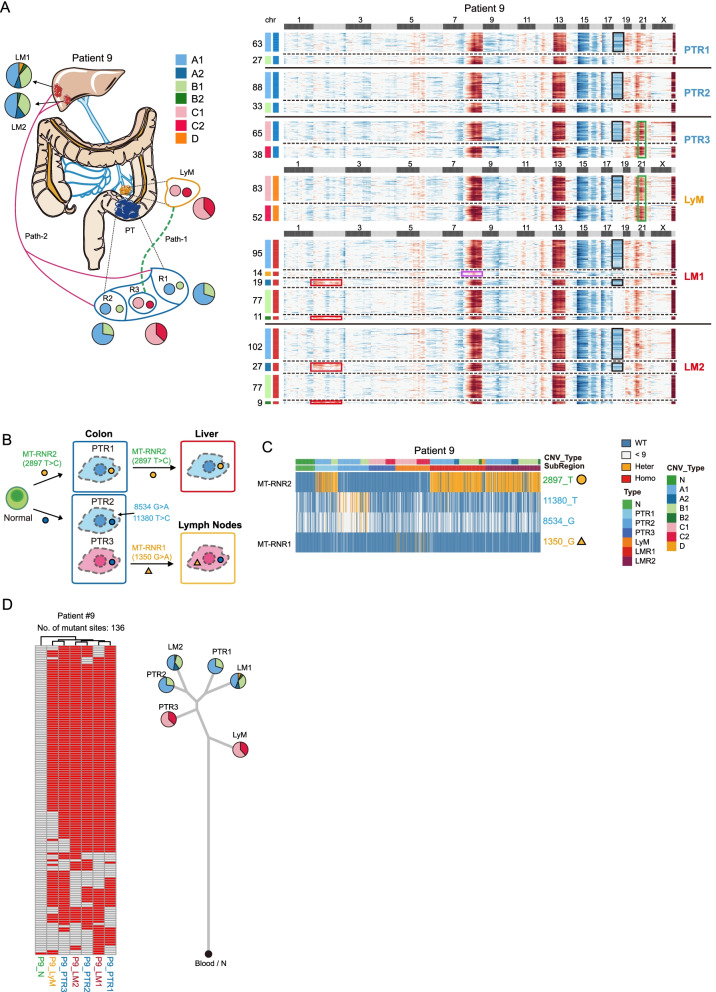Fig. 4.
Tumor clonal architectures and tumor lineage inferences. A CNV pattern and sampling strategy of patient #9. Different subclones with distinct CNV patterns are found in lymph node and liver metastases. N: adjacent normal tissues. PT: primary tumors and R1-R3 represent different regions of primary tumor. LyM: lymph node metastasis. LM: liver metastasis and LM1 and LM2 represent two separated liver metastatic tumors. The pie charts reflect the proportion of different subclones in each region. Copy number gain and copy number loss are indicated with red and blue respectively. Different tissues are divided by bold black solid lines, and different clones within the same tissue block are divided by black dashed lines. The squares above the heatmap represent different chromosomes, black squares represent odd-numbered chromosomes and chromosome X, and light gray squares represent even-numbered chromosomes and chromosome Y. The squares on the left of the heatmap represent different subclones, and the same color represents the same clone. The most obvious copy number differences between different clones are highlighted by different colored boxes. Red squares in chromosome 2 show the additional CNVs of metastatic tumor (A2 and B2 subclones) compared to the primary tumor (A1 and B1 subclones). Pink square in chromosome 8 shows D subclone-specific CNV. Black squares in chromosome 18 show the A (A1 and A2) and C (C1 and C2) clones specific CNVs. Green squares in chromosomes 20 and 21 show C (C1 and C2) clone-specific CNVs. The numbers next to the heatmap show the number of cells of each subclone in different tissue blocks. B The diagram showing the tumor metastasis path of patient #9. The color of box represents different areas; blue, orange, and red boxes represent the primary tumor, lymphatic and liver metastasis tumor respectively. The circle and triangle represent the mutation state at the position 2897- and 1350-point site of mitochondria. Their colors represent the mutation status: blue, orange, and red represent wild-type, heterozygous, and homozygous mutations respectively. PT: primary tumors and R1-R3 represent different regions of primary tumor. C Heatmap showing selected mitochondrial mutations of patient #9. Orange represent heterozygous mutations and red represents homozygous mutations. Blue represent wild-type and gray represents read depth lower than 9. Cells from PTR1 and liver metastasis have a chrM:2897 heterozygous mutation. PTR2 has region-specific mutations on chrM:11380 and chrM:8534. The bars above the heatmap shows the CNV subclones and tissue origin of the cells. The full list of mitochondrial mutations can be found in supplementary table 5. PT: primary tumors and R1-R3 represent different regions of primary tumor. LyM: lymph node metastasis. LM: liver metastasis and LM1 and LM2 represent two separated liver metastatic tumors. D Heatmap showing the reginal distribution of somatic mutations in all samples from patient #9. In total, 136 somatic mutations that were shared by at least two samples were identified. Red represent mutant state and gray represent wild-type state (left panel). Phylogenetic tree of lesions of patient #9 based on somatic mutations calling by WES data and the pie charts reflect the proportion of different subclones in each region based on CNVs that inferred by scRNA-Seq data

